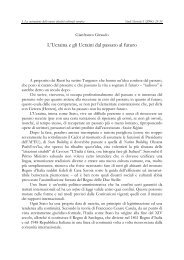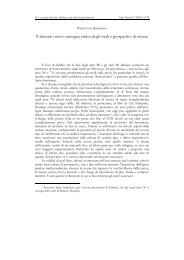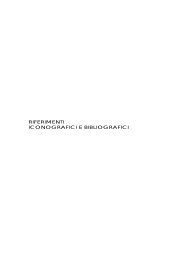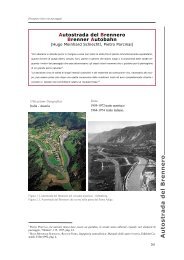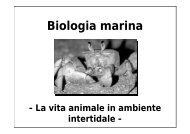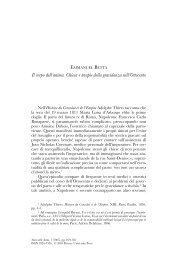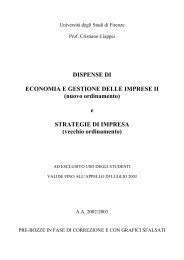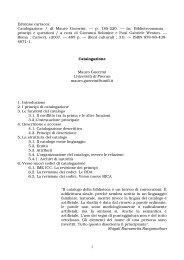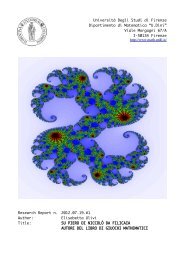194Strumenti della rete e processo formativoFjuk A., Ludvigsen S. (2001), The Complexity of Distributed Collaborative Learning: Unitof Analysis, in Procee<strong>di</strong>ngs of Euro-CSCL 2001, Maastricht, 22-24 March 2001Fjuk A., Smørdal O. (2001), Networked Computers’ Incorporated Role in CollaborativeLearning in Procee<strong>di</strong>ngs of Euro-CSCL 2001, Maastricht, 22-24 March 2001Flavell J.H, Wellman H.M. (1977), Metamemory, in Kail R.V., Hagen J.W. (eds.),Perspectives on the Development of Memory and Cognition, Lawrence ErlbaumAssociated inc., Hillsdale NJFlavell J.H, Wellman H.M. (1981), Cognitive Monitoring, in Dikson W.P. (ed.), Children’sOral Communication Skills, Academic Press, New York, pp. 35-60Flichy P. (1995), L'innovation technique, E<strong>di</strong>tions La Découverte, ParisFrauenfelder E., Santoianni F. (eds., 2003), Mind, learning and Knowledge in Educationalcontext, Cambridge Scholar Press, CambridgeGalimberti C., Riva G. (1997), La comunicazione virtuale. Dal computer alle retitelematiche: nuove frontiere per l’interazione sociale, Guerini e Associati, MilanoGalliani L., Costa R., Valutare l’e-learning, Pensa Multime<strong>di</strong>a. Lecce, 2003Gardner H. (1987), Formae mentis. Saggio sulla pluralità dell’intelligenza, Feltrinelli,Milano (ed. orig. 1985)Gardner H. (1993), Educare al comprendere : stereotipi infantili e appren<strong>di</strong>mentoscolastico, Feltrinelli, Milano (ed. orig. 1991)Garrison D.R., Anderson T., Archer W. (2000), Critical Inquiry in a Text-BasedEnvironment: Computer Conferencing in Higher Education, manoscritto non pubblicato,<strong>di</strong>sponibile in Internet all’in<strong>di</strong>rizzo:http://communitiesofinquiry.com/documents/CTinTextEnvFinal.pdfGarrison G.R. (1985), Three generation of technological innovation, in Distance Education,n.6, 1985, pp. 235-241Genovese A., Corazza L. (2002), Nuovi me<strong>di</strong>a in educazione: I software ‘edutainment’,analisi e valutazione della loro qualità, in <strong>Stu<strong>di</strong></strong> sulla formazione, anno V, n.1, Ge<strong>di</strong>t,Bologna, pp.41-61Gensini S. (2002), Elementi <strong>di</strong> semiotica, Carocci, RomaGeorgou<strong>di</strong> M., Rosnow R.L. (1985), The Emergence of Contextualism, in Journal ofCommunication, n.35, 1985, Philadelphia, Pennsylvania State University, pp. 76-88.Giani U. (2004), Reti <strong>di</strong>namiche <strong>di</strong> appren<strong>di</strong>mento a <strong>di</strong>stanza, Liguori, NapoliGibson J. (1977), The theory of affordance, in R. Shaw, J. Bransford (ed.), Perceiving,acting, and knowinng, Lawrence Erlbaum Associates, Hillsdale, NJGibson J. (1979), The ecological approach to visual perception, Houghton Mifflin, BostonGibson W. (1984), Neuromancer, Ace Books, New YorkGiese M. (2002), Self without body: Textual Self-Representation in an ElectronicCommunity, <strong>di</strong>sponibile all’in<strong>di</strong>rizzo Internet:http://www.firstmonday.dk/issues/issue3_4/giese/index.htmlGoody J. (1981) L’addomesticamento del pensiero selvaggio, Angeli, Milano (ed. orig.1977)Goody J. (2002) Il potere della tra<strong>di</strong>zione scritta, Bollati Boringhieri, Torino (ed. orig. 2000)
Strumenti della rete e processo formativo 195Greeno J.G. (1998), The Situativity of Knowing, Learning, and Research, in AmericanPsychologist, 53, 1, pp.5-26.Groppo M. (1995), Prefazione a: Liverta Sempio O., Marchetti A. (a cura <strong>di</strong>), Il pensierodell’altro. Contesto, conoscenza e teorie della mente, Raffaello Cortina E<strong>di</strong>tore, Milano,pp.XV-XVIIIGroppo M., Locatelli M.G. (1996), Mente e cultura. Tecnologie della comunicazione eprocessi educativi, Raffaello Cortina, MilanoGunawardena C.N., Zittle F. (1997), Social presence as a pre<strong>di</strong>ctor of satisfaction within acomputer me<strong>di</strong>ated conferencing environment, in American Journal of DistanceEducation, 11(3), pp. 8-25Guz<strong>di</strong>al M. (1997), Information ecology of collaborations in educational settings: Influenceof tool, documento presentato al CSCL’97, Toronto, in Internet:http://guz<strong>di</strong>al.cc.gatech.edu/papers/infoecol/Hakkarainen K. (2003), Emergence of progressive-inquiry culture in a Computer-supportedcollaborative learning, Learning Environments Research, 6, 2Hanks W.F. (1991), Foreword, in Lave J., Wenger E.C., Situated Learning. Legitimateperipheral participation, Cambridge University Press, Cambridge MAHarasim L. (1990), Online education: perspectives on a new environment, Praeger, NewYorkHarasim L. (1995), Learning networks: a field guide to teaching on learning online, TheMIT Press, Cambrige, MAHarasim L. (1997), Interacting in hyperspace: Developing collaborative learningenvironments on the WWW. Disponibile in Internet all’in<strong>di</strong>rizzo:http://www.umuc.edu/ide/potentialweb97/harasim.htmlHarel I., Papert S. (1991), Constructionism, Ablex Publishing Corporation, Norwood NJ (ilprimo capitolo è <strong>di</strong>sponibile in Internet all’in<strong>di</strong>rizzo:http://www.papert.org/articles/SituatingConstructionism.html)Hatch T., Gardner H. (1993), Fin<strong>di</strong>ng cognition in the classroom: an expanded view ofhuman intelligence, in G. Salomon (ed.), Distributed cognitions. Psychological andeducational considerations, Cambridge, Cambridge University Press, Cambridge MA,pp. 164-187Havelock E.A. (1973), Cultura orale e civiltà della scrittura, Laterza, Roma-Bari (ed. orig.1963)Havelock E.A. (1987), Dall’A alla Z. Le origini della civiltà della scrittura in Occidente, IlMelangolo, Genova (ed. orig. 1976)Hill W.F. (2000), L’appren<strong>di</strong>mento. Una rassegna delle teorie dell’appren<strong>di</strong>mento inpsicologia, Zanichelli, BolognaHimanen P. (2003), L’etica hacker e lo spirito dell’età dell’informazione, Feltrinelli, MilanoHutchins E.L. (1995), Cognition in the Wild, The MIT Press, Cambridge MAHutchins E.L., Hollan J.D., Norman D.A. (1985), Direct manipulation interfaces, in Human-Computer Interaction, 1, pp. 311-338.Hyppönen H. (1998), Activity Theory As A Basis For Design For All, Dissertazionepresentata al terzo Congresso TIDE, 23-25 June 1998, Helsinki, Finland,http://www.stakes.fi/tidecong/213hyppo.htm
- Page 1 and 2:
TESIUMANISTICA- 3 -
- Page 3 and 4:
Giovanni BonaiutiStrumenti della re
- Page 5 and 6:
Strumenti della rete e processo for
- Page 7 and 8:
Strumenti della rete e processo for
- Page 9 and 10:
Strumenti della rete e processo for
- Page 11 and 12:
Teorie, modelli e artefatti per la
- Page 13 and 14:
Teorie, modelli e artefatti per la
- Page 15 and 16:
Teorie, modelli e artefatti per la
- Page 17 and 18:
Teorie, modelli e artefatti per la
- Page 19 and 20:
Teorie, modelli e artefatti per la
- Page 21 and 22:
Teorie, modelli e artefatti per la
- Page 23 and 24:
Teorie, modelli e artefatti per la
- Page 25 and 26:
Teorie, modelli e artefatti per la
- Page 27 and 28:
Teorie, modelli e artefatti per la
- Page 29 and 30:
Teorie, modelli e artefatti per la
- Page 31 and 32:
Teorie, modelli e artefatti per la
- Page 34 and 35:
32Strumenti della rete e processo f
- Page 36 and 37:
34Strumenti della rete e processo f
- Page 39 and 40:
Teorie, modelli e artefatti per la
- Page 41 and 42:
Teorie, modelli e artefatti per la
- Page 43 and 44:
Teorie, modelli e artefatti per la
- Page 45 and 46:
Teorie, modelli e artefatti per la
- Page 47 and 48:
Teorie, modelli e artefatti per la
- Page 49 and 50:
Teorie, modelli e artefatti per la
- Page 51 and 52:
Teorie, modelli e artefatti per la
- Page 53 and 54:
Teorie, modelli e artefatti per la
- Page 55 and 56:
Teorie, modelli e artefatti per la
- Page 57 and 58:
Teorie, modelli e artefatti per la
- Page 59 and 60:
Teorie, modelli e artefatti per la
- Page 61 and 62:
Strumenti e ambienti per la formazi
- Page 63 and 64:
Strumenti e ambienti per la formazi
- Page 65 and 66:
Strumenti e ambienti per la formazi
- Page 67 and 68:
Strumenti e ambienti per la formazi
- Page 69 and 70:
Strumenti e ambienti per la formazi
- Page 71 and 72:
Strumenti e ambienti per la formazi
- Page 73 and 74:
Strumenti e ambienti per la formazi
- Page 75 and 76:
Strumenti e ambienti per la formazi
- Page 77 and 78:
Strumenti e ambienti per la formazi
- Page 79 and 80:
Strumenti e ambienti per la formazi
- Page 81 and 82:
Strumenti e ambienti per la formazi
- Page 83 and 84:
Strumenti e ambienti per la formazi
- Page 85 and 86:
Strumenti e ambienti per la formazi
- Page 87 and 88:
Strumenti e ambienti per la formazi
- Page 89 and 90:
Strumenti e ambienti per la formazi
- Page 91 and 92:
Strumenti e ambienti per la formazi
- Page 93 and 94:
Strumenti e ambienti per la formazi
- Page 95 and 96:
Strumenti e ambienti per la formazi
- Page 97 and 98:
Strumenti e ambienti per la formazi
- Page 99 and 100:
Strumenti e ambienti per la formazi
- Page 101 and 102:
Strumenti e ambienti per la formazi
- Page 103 and 104:
Strumenti e ambienti per la formazi
- Page 105 and 106:
Strumenti e ambienti per la formazi
- Page 107 and 108:
Strumenti e ambienti per la formazi
- Page 109 and 110:
Strumenti e ambienti per la formazi
- Page 111 and 112:
Strumenti e ambienti per la formazi
- Page 113 and 114:
Strumenti e ambienti per la formazi
- Page 115 and 116:
Strumenti e ambienti per la formazi
- Page 117 and 118:
Strumenti e ambienti per la formazi
- Page 119 and 120:
Strumenti e ambienti per la formazi
- Page 121 and 122:
Strumenti e ambienti per la formazi
- Page 123 and 124:
Strumenti e ambienti per la formazi
- Page 125 and 126:
Strumenti e ambienti per la formazi
- Page 127 and 128:
Strumenti e ambienti per la formazi
- Page 129 and 130:
L’indagine empirica e le verifich
- Page 131 and 132:
L’indagine empirica e le verifich
- Page 133 and 134:
L’indagine empirica e le verifich
- Page 135 and 136:
L’indagine empirica e le verifich
- Page 137 and 138:
L’indagine empirica e le verifich
- Page 139 and 140:
L’indagine empirica e le verifich
- Page 141 and 142:
L’indagine empirica e le verifich
- Page 143 and 144:
L’indagine empirica e le verifich
- Page 145 and 146: L’indagine empirica e le verifich
- Page 147 and 148: L’indagine empirica e le verifich
- Page 149 and 150: L’indagine empirica e le verifich
- Page 151 and 152: L’indagine empirica e le verifich
- Page 153 and 154: L’indagine empirica e le verifich
- Page 155 and 156: L’indagine empirica e le verifich
- Page 157 and 158: L’indagine empirica e le verifich
- Page 159 and 160: L’indagine empirica e le verifich
- Page 161 and 162: L’indagine empirica e le verifich
- Page 163 and 164: L’indagine empirica e le verifich
- Page 165 and 166: L’indagine empirica e le verifich
- Page 167 and 168: L’indagine empirica e le verifich
- Page 169 and 170: L’indagine empirica e le verifich
- Page 171 and 172: L’indagine empirica e le verifich
- Page 173 and 174: L’indagine empirica e le verifich
- Page 175 and 176: L’indagine empirica e le verifich
- Page 177 and 178: Strumenti della rete e processo for
- Page 179 and 180: Strumenti della rete e processo for
- Page 181 and 182: Strumenti della rete e processo for
- Page 183 and 184: Strumenti della rete e processo for
- Page 185 and 186: Strumenti della rete e processo for
- Page 187 and 188: Strumenti della rete e processo for
- Page 189 and 190: Strumenti della rete e processo for
- Page 191 and 192: Strumenti della rete e processo for
- Page 193 and 194: Strumenti della rete e processo for
- Page 195: Strumenti della rete e processo for
- Page 199 and 200: Strumenti della rete e processo for
- Page 201 and 202: Strumenti della rete e processo for
- Page 203 and 204: Strumenti della rete e processo for
- Page 205 and 206: Strumenti della rete e processo for
- Page 207 and 208: Strumenti della rete e processo for
- Page 209: RingraziamentiRingrazio nella perso



